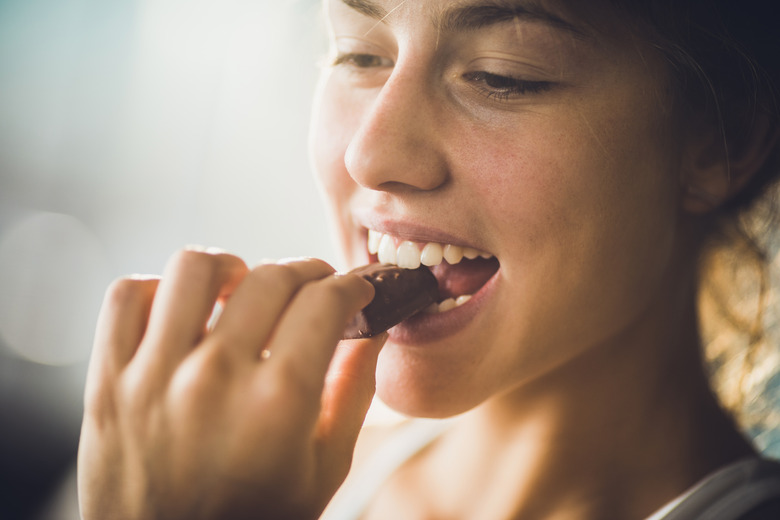This Is Why You Like Chocolate So Much
Happy Valentine's Day! And whether you're spending the day with your valentine, throwing a Galentine's Day dinner or just cozying in at home for a Netflix binge, we hope there's plenty of chocolate involved.
Why's that? Well, obviously, chocolate tastes delicious (bonus points if you pair it with peanut butter). But it also has unique chemical properties that mean chocolate-making is an art form. Plus, it has a fascinating impact on your brain chemistry.
So grab a chocolate truffle or three and settle in. Here's why chocolate looks and tastes so yummy (and makes you feel so great).
What's in Chocolate, Anyway?
What's in Chocolate, Anyway?
Before getting into the nitty gritty of chocolate's chemistry, let's chat about what's actually in chocolate. While each bar and candy has its own recipe, chocolates are generally made up of cocoa solids (basically, the dark brown and bitter stuff that makes up cocoa powder), cocoa butter (the fat that occurs naturally in cocoa beans) and sugar.
Some chocolates also have milk added (hello, milk chocolate!), along with other flavorings or add-ins.
The Chemical Structure of Chocolate
The Chemical Structure of Chocolate
Now that we know the basics, let's get down to the molecular level. The thing that separates great chocolate – glossy and sweet with a satisfying snap – from dull, grainy or almost moldy-looking chocolate is a process called tempering.
Tempered chocolate looks the way it does because of crystallization. When it's tempered properly, the fatty acids that make up the cocoa butter crystallize in an organized pattern, giving the chocolate an attractive uniform look.
If the fatty acids don't crystallize properly, though, they never arrange into neat little crystals. And that untempered chocolate looks, well, not so appealing. The free-form fatty acids can bunch together, creating a blotchy-looking bar.
TL;DR (Too Long; Didn't Read)
While tempering chocolate takes some skill, _un-tempering_ it is easy. If you want to see the difference crystallized fatty acids makes for yourself, simply place a chocolate bar in a bowl and microwave in 10-second intervals until it's melted, then allow it to cool to room temperature. Voila – unattractive untempered (but still tasty!) chocolate!
Chocolate and Your Brain
Chocolate and Your Brain
So now you know the science of why well-made chocolate looks so appetizing. But why does a bar of chocolate feel so comforting?
It all comes down to how the compounds in chocolate impact your brain chemistry.
See, chocolate is a great source of an amino acid called tryptophan. While tryptophan has several roles in your body, like helping produce proteins, it's also a precursor to certain brain hormones. One of them is serotonin, a natural "feel-good" hormone that boosts your mood.
The sugar in chocolate also promotes serotonin release, by the way, which means chocolate does double duty in making you feel happier.
Finally, chocolate contains a chemical called theobromine. As an antioxidant, theobromine is responsible for some of the health benefits linked to dark chocolate, like a lower risk of heart disease. But it's also a natural stimulant. So it will feel happier and more alert – and ready to focus on a fantastic date with your Valentine.
Cite This Article
MLA
Tremblay, Sylvie. "This Is Why You Like Chocolate So Much" sciencing.com, https://www.sciencing.com/this-is-why-you-like-chocolate-so-much-13717222/. 14 February 2019.
APA
Tremblay, Sylvie. (2019, February 14). This Is Why You Like Chocolate So Much. sciencing.com. Retrieved from https://www.sciencing.com/this-is-why-you-like-chocolate-so-much-13717222/
Chicago
Tremblay, Sylvie. This Is Why You Like Chocolate So Much last modified March 24, 2022. https://www.sciencing.com/this-is-why-you-like-chocolate-so-much-13717222/
